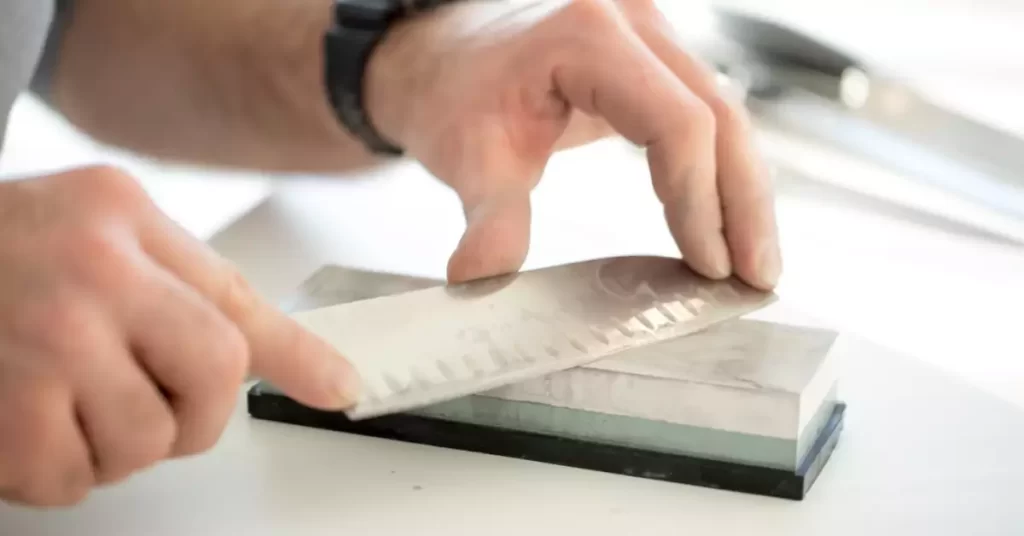Cooking is an art, and the knife is the most important tool in any chef’s arsenal. A good quality knife not only makes cooking easier and faster but also enhances the flavor of your food.
The Kamikoto knife is a popular choice among many professional chefs due to its high-quality steel, sharpness, and durability. However, even the best knives need to be sharpened over time to maintain their edge.
In this article, we will discuss how to sharpen a Kamikoto knife with a whetstone, a traditional sharpening tool used by many chefs.
How To Sharpen a Kamikoto Knife Using Whetstone
Part 1: Understanding the basics of knife sharpening
Before we dive into the process of sharpening a Kamikoto knife with a whetstone, it is important to understand the basics of knife sharpening.
The sharpness of a knife depends on the angle of the edge, which is usually measured in degrees. A lower angle produces a sharper edge, but it is also more delicate and prone to chipping.
A higher angle, on the other hand, produces a less sharp but more durable edge.
To sharpen a knife, you need to remove a small amount of metal from the blade’s edge to create a new edge.
This is done by running the blade against a sharpening tool, such as a whetstone. The whetstone’s surface is coated with an abrasive material, usually diamond or ceramic, which grinds away the metal to sharpen the blade.

Part 2: Preparing the whetstone and knife
Before you start sharpening your Kamikoto knife, you need to prepare the whetstone and the knife. Begin by soaking the whetstone in water for 10-15 minutes to ensure that it is properly lubricated.
Next, place the whetstone on a stable surface, such as a table or countertop, with the coarse side facing up.
Now, inspect your Kamikoto knife for any nicks, chips, or other damage that may affect the sharpening process.
If the blade is damaged, it is best to have it professionally repaired before attempting to sharpen it.
Part 3: Sharpening the Kamikoto knife
Now it is time to sharpen the Kamikoto knife with the whetstone. Begin by holding the knife at a 15-20 degree angle to the whetstone, with the blade facing away from you.
Place your fingers on the blade’s spine and gently apply pressure to the edge as you draw it along the stone’s surface.
Repeat this process several times, starting from the base of the blade and working your way up to the tip.
After sharpening the blade on the coarse side of the whetstone, switch to the finer side and repeat the process. This will help to refine the edge and remove any remaining burrs or rough spots.
Part 4: Honing the Kamikoto knife
Once you have finished sharpening the Kamikoto knife, it is time to hone it. Honing is the process of realigning the edge of the blade, which can become misaligned over time.
To hone the knife, hold it at a 15-20 degree angle to the honing steel and draw it along the steel’s surface, starting at the base of the blade and working your way up to the tip.
Repeat this process several times, alternating sides of the blade with each stroke. This will help to restore the blade’s sharpness and ensure that it is properly aligned.
FAQs
How often should I sharpen my Kamikoto knife?
It depends on how often you use the knife. As a general rule, knives should be sharpened every few months or when you notice that the blade is becoming dull or less effective.
However, this can vary depending on the quality of the knife, how often it is used, and the type of food it is used to cut.
Can I sharpen my Kamikoto knife with an electric sharpener?
While it is possible to sharpen a Kamikoto knife with an electric sharpener, it is not recommended. Electric sharpeners can remove too much metal from the blade and damage the edge.
Hand sharpening with a whetstone allows for more control and precision, resulting in a sharper and more durable edge.
How do I know when the knife is properly sharpened?
You can test the sharpness of your Kamikoto knife by gently slicing through a piece of paper or a tomato. If the blade cuts cleanly and smoothly without any tearing or crushing, then it is properly sharpened.
Final Verdict
Sharpening a Kamikoto knife with a whetstone may seem daunting at first, but with practice and patience, it can become a satisfying and rewarding process.
Remember to always use a stable surface and to properly prepare the whetstone before sharpening the knife.
Take your time and use a consistent angle and pressure to achieve the best results. By following these steps, you can maintain the sharpness and effectiveness of your Kamikoto knife for years to come.
